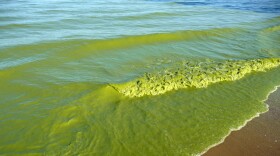-
A new report suggests Michigan and Ohio will fail to reduce nutrient runoff by 40% as agreed upon.
-
The toxic cyanobacterial bloom that’s become a yearly problem in Lake Erie’s western basin was relatively small this year. But the bloom has lasted an unusually long time. It didn't start to break up until recently.
-
Michigan and Ohio are among the worst places in America that spread liquid manure — and that's having an impact on Lake Erie.
-
Billions spent on strategies to limit nutrient pollution that don't work.
-
Fertilizer that runs off farm fields can fuel cyanobacterial blooms on lakes and rivers. Agriculture Secretary Tom Vilsack estimated 28% of U.S. cropland is over-fertilized.
-
A new report indicates smaller animal farms that don't need a permit are responsible for more than 60% of the phosphorus that can get into Lake Erie.
-
Public pressure is growing over toxic cyanobacteria blooms growing in the western basin of Lake Erie and other places in Michigan.
-
Long-term forecasts of less rain leads researchers to predict there will be a less severe outbreak of harmful cyanobacterial blooms. But where and when storms might hit, the number of hot days, and wind direction all complicate the forecast.
-
American and German scientists found removing phosphorus alone could trigger a change that would mean more toxins from harmful algal blooms.
-
Data from the Ohio EPA show the additional costs at water treatment plants are paid by customers, not polluters.
Play Live Radio
Next Up:
0:00
0:00
Available On Air Stations









